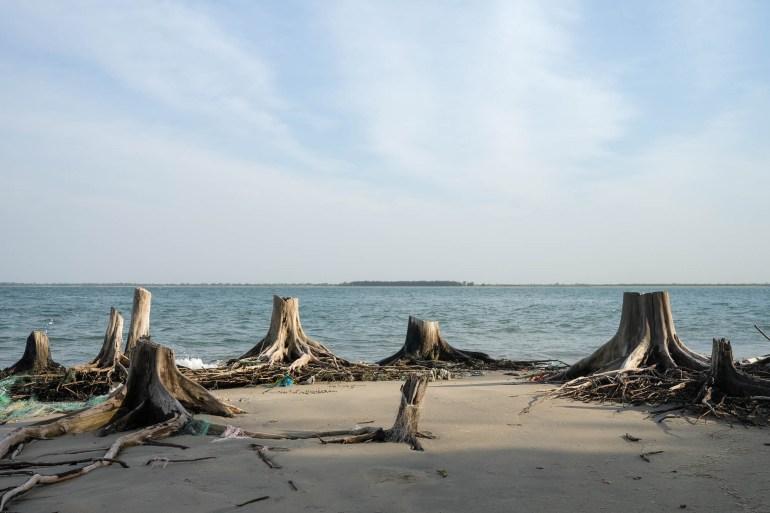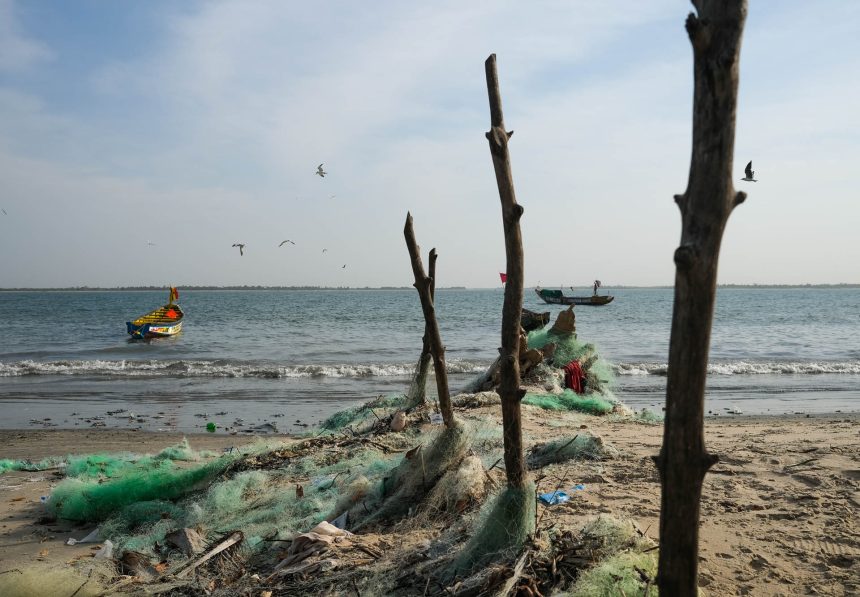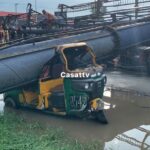[ad_1]
Diogué Island, Senegal – When Cherif Diatta was a child, he used to play football on a beach on Diogué, an island at the mouth of the Casamance River in southern Senegal. On that same spot nearly five decades later, there are boats floating in deep water.
“And it [seawater] keeps moving faster and faster,” said Diatta, 66, now the island’s chief.
The consequences of the water chewing away at Diogué’s coastline are visible.
Residents are retreating inland and paddy fields are replaced by mangroves. Tree corpses dot the beaches, their decaying roots choked by the advancing saline groundwater. As seawater creeps in, locals have had to abandon the island’s main cistern and relocate the primary school.
“This spot where we are sitting now, it’s not sure it will be there tomorrow,” said Diatta, standing on the beach a few metres from the water.

Experts say the steady and growing retreat of Diogué’s shoreline is a result of climate-driven rising sea levels.
As global temperatures rise, partly due to the increased production of greenhouse gases that trap heat in the atmosphere, glaciers and ice sheets melt faster than they gain new snow. This sends more water into the sea, which strengthens tides and waves and leads to coastal erosion, flooding and saltwater infiltration.
West Africa, where Senegal lies, is one of the world’s most vulnerable regions to the impacts of climate change, including rising sea levels, despite producing just about two percent of global emissions.
Senegal’s 718km (446-mile) coastline is key to its social fabric and economy. Exposed to the Atlantic Ocean, it is home to most of the country’s population and economic activity – from fishing to agriculture – and contributes to nearly 70 percent of its gross domestic product.
But the low and sandy shores receded by up to 3m (10 feet) between 2014 and 2018, according to a report by the Journal of Coastal Erosion. In Diogué, the retreat over the past decade was about 50m (164 feet). Such an encroachment has both altered the ecosystem and threatened livelihoods, with the World Bank putting the nationwide cost at more than $500m a year.
“Mankind sped up the process due to their own development, which is a process of self-destruction – it’s pretty unsettling,” said Boubou Aldiouma Sy, a geography professor at Saint-Louis’s Gaston Berger University.
“Places like Diogué,” Sy added solemnly, “will disappear”.
![[Diogue]](https://www.aljazeera.com/wp-content/uploads/2023/01/DSCF1400.jpg?w=770&resize=770%2C513)
![[Virginia Pietromarchi/Al Jazeera]](https://www.aljazeera.com/wp-content/uploads/2023/01/DSCF1465-1.jpg?w=770&resize=770%2C513)
Like people in the rest of the Casamance region, most residents of Diogué rely on fishing. But as the seawater advances, it kills off vegetation which, in turn, affects several fish species that rely on ecosystems such as mangroves for breeding and spawning.
Agriculture production has not been spared, either. The seawater’s infiltration of the land has resulted in the groundwater becoming too saline, hence unsuitable for growing food such as rice, which plays a key role in the diet of families across the region.
While the traditional staple is mostly intended to be consumed at home, and not to be sold, a decrease in its local production has worsened food insecurity and poverty, according to PAPSENPAIS, an organisation focusing on Senegal’s agriculture development.
The National Network of Development Actors of Senegal estimates that saltwater every year destroys 25 to 30 percent of rice paddies along the Casamance River – from the regional capital Ziguinchor, to Sédhiou, further east.
“Water advances, and poverty along with it,” said Bruno Bouyoyo Diatta, the traditional chief of Kabrousse, near the tourist destination of Cap Skirring, where paddy fields have been replaced by dry lands.
Over the past four decades, half of the village has abandoned rice production, he said. The situation is compounded by many young people opting to migrate to urban areas, or work in the region’s holiday resorts, rather than working the fields.
![[Virginia Pietromarchi/Al Jazeera]](https://www.aljazeera.com/wp-content/uploads/2023/01/DSCF0973.jpg?w=770&resize=770%2C513)
![[Virginia Pietromarchi/Al Jazeera]](https://www.aljazeera.com/wp-content/uploads/2023/01/DSCF1219.jpg?w=770&resize=770%2C513)
Still, those staying behind are trying to adapt – and fight back.
In Kabrousse, bottom-up projects that have sprung up among the locals include erecting barriers to slow down the saltwater intrusion.
“Farming is all we have,” Bouyoyo Diatta explained.
And in Diogué, Patrick Chevalier, professor of economy at Ziguinchor University, has dug into techniques pioneered in Australia and Canada to address similar erosion-related issues.
In 2019, he embarked with a team of local volunteers on an experiment that involved planting wooden sticks along the beach and placing coconut leafy branches at their base with the goal of trapping the sand and preventing it from washing away.
And it worked. Three years later, the beach expanded up to 30m (100 feet) in certain parts of the island.
Today Chevalier, in collaboration with local authorities, has won funds from the Senegalese government to expand the project to the wider area.
Local producers whose paddies dried up, meanwhile, have set their sights on oyster farming instead of growing rice, as part of the same initiative.
“It’s important to think in terms of integrated management, meaning to adapt the territory to protect certain areas while converting others,” said Chevalier. “It’s a matter of being active rather than passive.”
However, he acknowledged that such projects are not enough to respond to the great challenges posed by rising sea levels.
“The situation will worsen,” Chevalier warned. “It will be harder in the years to come, but we have to start working now to organise the territory to make it ready to cope. If we don’t do anything today, in 20 years it will be a catastrophe.”
![Patrick Chevalier started an experiment in 2019 planting wooden sticks along Diogue’s beach placing coconut leafy branches at their base that would trap the sand and avoid it from washing away [Virginia Pietromarchi/Al Jazeera]](https://www.aljazeera.com/wp-content/uploads/2023/02/DSCF1366.jpg?w=770&resize=770%2C513)
[ad_2]
Source link









